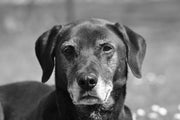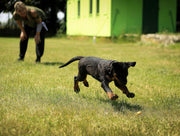
Many people consider dogs' coat type to choose which dog breed to adopt or rescue. Sometimes, they make a decision based on their allergy situation. While there is no perfect coat and all dogs are equally precious, dog owners should know what level of maintenance is expected based on their dog's coat type.
A recurring question for some dog breeds specifically and when going to the groomer is: what is matting? How to prevent matting?
What is matting?

Mats form when dog fur gets tangled and wraps around itself. Dead and live hair get tangled and form clumps that are hard to brush or remove. The longer dog owners wait, the more clumping and the closer it gets to the dog's skin.
Matting tends to happen more when your dog is shedding. Therefore, it's important to brush out the dead coat. Matting also frequently happens when dogs go swimming since their hair curls when drying. Therefore, when bathing your dog, make sure to brush them and dry them afterward thoroughly.
Matting can eventually get close to the skin and cause skin rashes and infections.
Which dog breeds are prone to matting
Some dog breeds have longer coats with curly hair or even double coats. These breeds are more prone to matting.
Such as breeds are:
- Breeds with curly-coated breeds: Poodles, Bichon Frisé
- Breeds with long coat: Bearded Collies, Rough Coat Collies
These are just examples. Matting doesn't happen as much with shorter-coat breeds.
Causes of matting

Generally, matting will occur in areas of high friction:
- Behind your dog's ears
- Your dog's neck area, where the collar sits
- Some areas where you pet your dog
How to prevent matting
Matting is hard to remove once it is very developed. However, the good news is that it's easy to prevent. But, depending on your dog's coat, it may require daily or weekly maintenance.
The best way to prevent matting and skin complications is to groom your dog regularly. Brush your dog's coat at least once a week. If your dog has a longer coat, I encourage you to brush your dog daily. Remove outside elements that sometimes get stuck in your dog's fur: leaves, sticks, etc.
Younger dogs might already groom themselves, and you won't need to groom them as much. However, older dogs will need your help.
You may brush your dog more frequently during shedding season and less regularly the rest of the year. But, ultimately, all you need to do is inspect your dog's coat periodically, and if you notice matting is starting to form, you should groom your dog more frequently.
Don't just focus on the outer coat when brushing your dog's skin. If your dog has a double coat, consider using an undercoat rake or a rotating pin comb if your dog has a curly coat.
Home remedy for matting

If you notice clumps of hair and matting starting to form, you may still have time to resolve the issue. I recommend making the following home remedy:
- Use a spray bottle
- Mix half Aloe Vera gel and half Coconut Oil
Step 1: brush your dog
Using a metal matting brush, brush your dog all over and locate where matting occurs. Don't brush too hard in these areas, as you could cause skin damage and pain to your pup.
Step 2: spray the detangler
After locating the matting areas, spray them generously with the mix you prepared.
Step 3: detangle using your fingers
Work the clump with your fingers and be extra gentle. If needed, add more detangler mix, and finish the detangling using your brush.
Extra tip: ask your groomer
If your dog's matting is too advanced or you can't seem to untangle some clumps, it's time to visit your groomer. While they might not do the detangling themselves, they will be able to show you what you need to do at home to take care of it.
Bonus: the different types of coats

You are probably curious about the different types of coats and which breed has which kind of coat. I compiled a list of the different coats and some examples of breeds for each one.
- Smooth coat: Great Dane, French Bulldog, Miniature Pinscher. It is short hair and close to the body, soft and shiny with no texture. It sheds weekly to twelve weekly.
- Short coat: Beagle, Pug, Rottweiler. This coat is close to the body but not harsh, easy to maintain, also high shedding.
- Combination coat: Golden Retriever, Australian Shepherd, Chihuahua. This coat is a combination of a long, silky coat and a short, smooth coat.
- Double coat: Siberian Husky, Shiba Inu. It is straight and short to moderate, long hair. It has a harsh outer coat and a soft undercoat.
- Heavy coat: Bernese Mountain Dog, Saint Bernard, Pomeranian. It is a combination of long, thick, silky hair and some short, smooth hair.
- Silky coat: English Setter, Cocker Spaniel. This coat is a combination of long, silky and short, smooth coat.
- Long coat: Bearded Collie, Tibetan Terrier. This coat is continually growing and is considered non-shedding.
- Curly, wavy, fleece coat: Afghan Hound, Shih Tzu, Yorkshire Terrier. This coat is also considered non-shedding soft, curly, wavy, or fleecy.
- Wire coat: Australian Terrier, Fox Terrier, Irish Wolfhound. This coat is a soft, dense undercoat and wire coat over the entire body.
- Hairless coat: Chinese Crested Dog, Peruvian Hairless Dog. This coat requires sensitive skin products.




